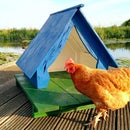Introduction: Hidden Box With Secret Opening Mechanism
When I read about this contest, I immediately wanted to make a secret storage area which was both hidden and had a secret opening mechanism. The mechanism had to be easy to make and I wanted to be able to open and close it quickly myself, but somebody else should really struggle to open it.
In the next steps, I will first explain how the mechanism works and after that I show you where it is hidden and how I made.
Step 1: How the Mechanism Works
I made a wooden box and the lid of the box is held in place by magnets and by pins.
The magnets are indicated by the red arrow on the photo. At the bottom side of the lid there are magnets on the same location as on the box, so when the lid is in place, it is held there by the magnets. With only the magnets, the lid could still easily be lifted, so that is where the pins come into play.
I drilled holes both in the box and in the lid. The location of the holes is indicated by the yellow arrows. On the photo you can only see one of the holes. The holes in the side wall of the box are not very deep (indicated by the red lines), so the pin can only partially enter into the hole. The holes in the lid are deep enough for the entire pin to enter. (Indicated by the blue lines.) The lid can only be opened when the pins are both completely in their blue hole in the lid. To realise that, you have to rotate the box counterclockwise and suddenly stop your movement. The inertia of the pins will make them move in the direction of the two black arrows, so they unlock the lid.
If you just hold the box on its side, both pins will drop to the bottom of their hole, but then always one of the pins will be in the shallow red hole of the side, so the lid cannot be opened.
Step 2: Finding a Location for the Hidden Box
We have cabinets with doors and when I opened a door and checked the size of the free area behind the top part of the cabinet, I saw that there was about 3 inches (7 centimeters) available. The only way to look into this area is by keeping my head really close to the floor and looking upwards into the cabinet. It is not very likely that somebody will look there, so I think it is a good hiding place. I just have to make sure that my box will be less than 3 inches high to be able to hide it there.
Step 3: Collecting Materials to Make the Box
I had some scrap pieces of oak and decided to use them, because my cabinet is also made of oak. I also had some magnets which you can use for example to attach some paper to the door of your fridge. These magnets are very cheap and I used a small screw driver to remove 4 magnets from their plastic cover.
Step 4: Making the Bottom Part of the Box
I took a piece which was large enough to make the bottom of the box and I cut four pieces to make the first layer of the side of the box. As you can see on the photo I made the bottom larger than the next layer, so I can use the ridge to grab the box when I remove it from its hidden location in the cabinet.
I also cut holes for the magnets and hammered them in place. I did not use glue to keep the magnets in place, but it is no problem to use some glue there.
Step 5: Making the Next Layer for the Box Including the Lid
The wooden parts for the third layer are more narrow than the ones of the second layer, because the lid has to rest on the second layer to create space for the locking pins.
I used a hammer and chisel to make a lower area where I could place the triangle shaped hook. The hook is needed to have something to hold the lid while lifting it for opening. I wanted the top side of the lid to be flat so I could attach it to the internal part of my cabinet.
Do not yet glue the wood of this layer because the holes for the pins still have to be drilled.
Step 6: Making Pins and Holes
I made the pins from nails and I cut them to the desired length. Make sure they have a smooth surface because they have to slide easily through the holes.
I drilled the shallow hole in the side wall of the box with a larger drill bit. This will help to prevent misallignment issues while glueing the wood in place. If the holes would be misalligned, the pin might get stuck in the lid and the then it would be difficult to lock the box. Don't make this hole too big, because then the lid can already move a bit upwards while it is still locked.
I drilled the deep hole in the lid just slightly wider than the pin, so the lid cannot move much, but the pin can easily slide. Make sure the deep hole is deep enough to contain the entire pin, but not much deeper than that.
Step 7: Mounting the Small Magnets in the Lid and Glueing the Box
Drill the holes for the magnets the same size as the magnets. Before you press, glue or hammer the magnets in place, check that they are oriented correctly so they attract eachother. I marked that position with a white marker, which helped me to install them correctly.
With the magnets and holes in place, you can glue all parts of the box. I also added a few nails after glueing for additional strength, but that is not really needed.
Step 8: Staining the Box and Adding Larger Magnets
I stained the bottom and sides of the box so the colour of the box matches with the colour of the cabinet. That way the box blends in with the rest of the cabinet as you can see on the photo.
I added some larger magnets to the side of the box and used a paper template to transfer and mark the correct position where I should drill the holes in the internal part of the cabinet. I drilled the holes and screwed the metal plates for the magnets in place.
Then I placed the box in the cabinet. It is really hidden because the height of my box in only 2 inches while the free space was 3 inches and the wood of the box looks similar to the wood of the cabinet.
Step 9: Using the Secret Storage
I put some money in the box, made sure the pins where installed, closed the lid and rotated it clockwise to lock the pins. Then I hid the box in the cabinet and closed the door.
If a thief would come into my house, it is unlikely that he finds the box. If he finds the box and has not read this instructable, he probably cannot immediately open the box. Of course he can just take the box with him and later use a saw to cut the box open, but at least I had fun making it and I hope you also enjoyed this instructable.

Participated in the
Secret Compartment Challenge











